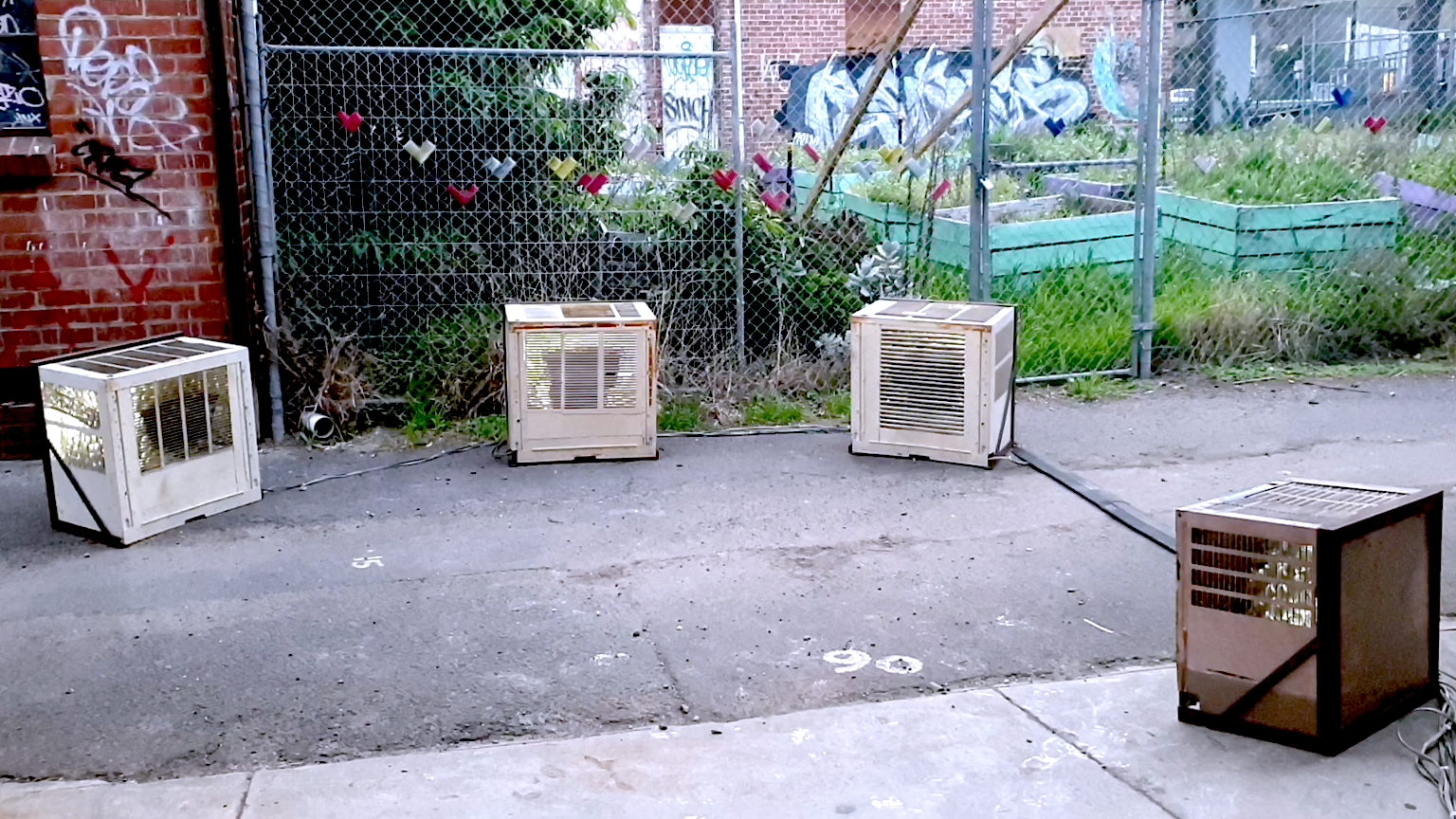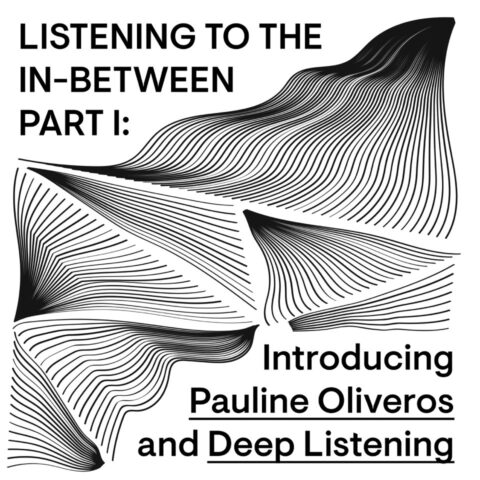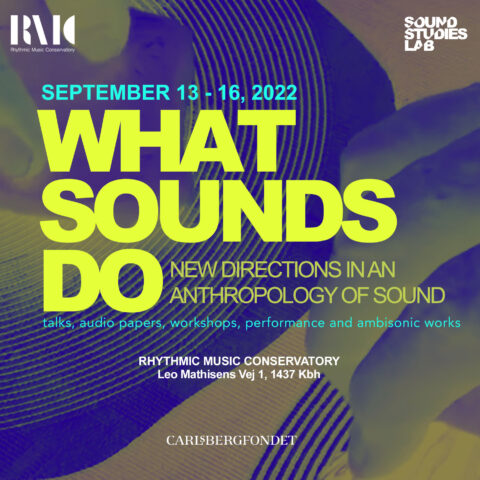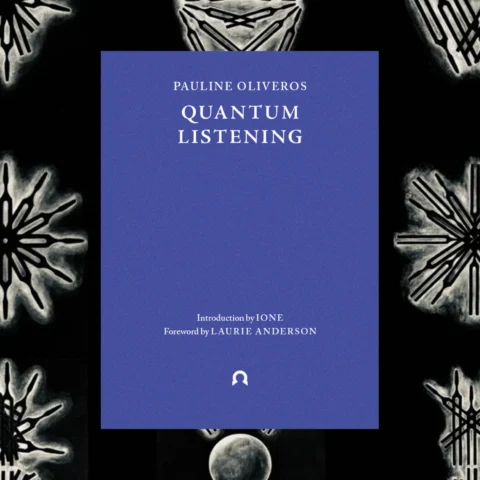A note from the editor, on Sonic, Social, Distance:
In an interview with Digicult, Salomé Voegelin describes, “I understand sound, exactly because of its formless in-between nature”.[1] As more than a third of the planet’s human population has gone into some sort of social restriction…self-isolation, social isolation, physical distancing, quarantine…since those who have the luxury of walls have gone behind them–time has not so much stood still, but fragmented and blurred. As artists of various media attempt to capture some essence of this time, it may be found that fragments, notes, moments, and blurs, are what express better our experienced time.
Sonic, Social, Distance, is calling for works on listening, and thinking about listening, in the time of social distance…alone together, together apart. We are calling for full texts, as well as text with media, or fragments and notes that will be curated and compiled together. This call is on-going, until it no longer makes sense. The full call and submission information will be forthcoming.
We launch this series with a work by creative practitioner, transdisciplinary researcher, author, musician and curator, Jordan Lacey, who specialises in soundscape design and the creation of public sound art installations. Dr. Lacey has been exploring the shifting blur, the “formless in-between”, between our Urban and Nature. With a postscript addressing our Now, and much content to consider towards what led to our Now, this work felt an excellent way to begin…
[1] http://digicult.it/articles/the-political-possibility-of-sound-interview-with-salome-voegelin/

Author note: This text is a flow of thoughts emerging from my recent experience of curating the “translating ambiance” exhibition at the Yarra Sculpture Gallery in Melbourne, Australia. The exhibition was the first stage of experimentation of a research project that is testing the notion that an ambiance can be translated between environments. Full documentation of the exhibition can be found at www.translating-ambiance.com. This text has a strong focus on Indigeneity, which is driven by my own historical experiences in Australian Aboriginal communities.
My body is located upon a division. On one side I touch the urban, and on the other, nature. But as I look groundward I see no division. Rather, a continuum of the Earth; grasses becoming concrete, and vice-versa; air flowing; the sun radiating. As I turn my back to the city, I see its roads weave their way into the forests and grasslands and wetlands. They become gravel roads rolling past signs identifying state-controlled parks – the same gravel roads delivering timber to the urban to create tables, paper and houses. Amongst the urban’s traffic and air-conditioned soundscapes, animals can be heard – singing birds, scurrying insects, foxes, hawks and rats. Trees line its streets and parks: uncontrolled ‘plants out of place’ (weeds) are everywhere. Bacteria swarms in the human body. It is apparent that these two places/spaces/typologies etc, have more commonalities than differences.
Was the urban/nature division considered prior to Australia’s invasion by Europeans (indeed, an event repeated across the planet’s lands)? I consider the people who inhabited their home (eco=eikos=home): what we now call nature. Australian Aboriginal nations managed the land with fire, stories and technology – shaping its becomings with an interconnected resonance where humanity was inseparable from the spirits and totems that inhabit the land. The aboriginal people were both sedentary, employing technologies – building huts, harvesting crops, practicing aquaculture [i] – and nomadic, particularly in the desert, reading the country with song and story [ii]. There was no urban/nature division here – they interwove. They were the same: home was an inseparable fusion of the two. Since the rupture of European arrival, these deep, timeless traditions have spiraled. Nothing is the same: the country burns; viruses swarm; mental health issues proliferate. Such are the consequences of severing our connection with the land, a wisdom we could have learnt from the Aboriginal peoples (if we listened).
Since Europe’s domination of the planet, global cities have grown exponentially to form the integrated paean we call Capitalism. Its paean sounds as the perpetual drone of city life, in which our bodies are suspended and propelled. These cities have become enormous, and now reduce us to an exhausting refrain – eat,work,play,sleep,repeat. The promise of the city helps us submit to this refrain – our cultural institutions and scholars who extol linear evolution [iii] assure us of our superiority over the primitives that preceded us, and our visits to the temples of consumerism (shopping centers, mainly) keep us sustained and satiated. Circa 1790, when the first Aboriginal (Eora tribe) person, Bennelong, to have (recorded) habitation with the Europeans escaped the comforts of Governor Arthur Philip’s home to return to his traditional lands, the Europeans were perplexed [iv]. Why would he return to a life of savagery, they wondered? I imagine. Bennelong goes back to his family, the stories and fishing – a sense of expansiveness returns, freed from the crippling refrains of the built environment, its structures and expectations… Such escape now seems impossible; unless, our relationships with the city might change.
Cities are crystallised conceptions: concepts becoming concrete and steel, representing to us our domination of the planet. Partly, their function is to convince us that we are superior to nature and its ‘primitives’, that we are advanced. Nature – once home – becomes a resource that feeds our labour force and commodity-based appetites, bloating the city. Simultaneously – the planetary remainder, nature (where the cities have not yet grown) becomes a type of sustenance device for those lost souls, who feel emotionally and spiritually diminished by the demands of urban life [v]. For them, nature is a place of reverence. Even while not immersed in its hallowed environs, they feel a tinge of satisfaction when peering at the landscape poster on their wall or the worn hiking boots brought for last year’s vacation. Nature becomes an object of longing, a place for escape. The division takes on a symbiotic relationship: the urban – our home – becomes profane and is held responsible for our diminishment, while nature, out there, becomes identified with something lost. Yet, this division is a mental overlay. It occurs as a consequence of our codifications [vi], and not due to any actual planetary division. In fact, this code enables a perpetuation of our sense of ownership and domination over the land: the urban is there to house us, while nature is there to sustain us. Nothing escapes the overcodings of contemporaneous global cultures.
This overcoding – the dictatorship of the signifier [vii] – manifests as infrastructures – both physical (cities, clothes, etc.) and semiotically (language, gesture, etc.). It reflects back at us our beliefs and assumptions; that the world is here simply to serve our purposes. In fact, the entirety of the planet is made subservient to the needs of the human subject – our right to consume and own. This code is metastasizing: [viii] the diminishing resources of the planet – the rural (food production) and nature (resource production) – directly relate to the bloating of our cities and the human bodies that live within. But the land beneath our feet – a transversal subjectivity [ix] that exceeds each and every human – recognises no codes. It simply exists in its becomings, evolutions and transformations. Eventually, this becoming-land will have swallowed all of our urbans and natures, creating the thinnest of planetary strata that may or may not be identifiable to future geologists/anthropologists. [x] The land’s expansiveness – spatial, temporal, energetic – is evidence of our fragility; but it is also a reminder of the intensities from which our own beings emerged.
These becomings of the land, and its powers to inform a culture’s spiritual and material life arguably re-emerge in the scholarship of posthumanism [xi] and vital materialism.[xii] These teach us that the material is vital: it is always becoming, and is immediately affecting. If we are to believe the claim that humans have always been posthuman [xiii] then this vitality might be considered consistent with the Aboriginal spirit of the land. This spirit is akin to an ineffable life force that never ceases creating. In the case of the city, this creative force is bridled and subordinated to the functional needs of the city (namely, its perpetuity). But the land’s ineffability continues to exceed a city’s power; it is not dependent on the city’s existence as the city is on it. This obvious asymmetrical relationship has been lost in the noise of contemporary ideas championing the acceleration of Capitalism. [xiv] Aboriginal Australians lived with the land respectfully and successfully for millennia – they care(d) for the land, and in return the land nourished them with deep knowledge (law) and abundance. [xv] They thrived for millennia, becoming-Earth through ritual. But the contemporary world has severed this connection. Rather, we transform the planet’s abundances into the cities – those crystallised concepts – that house us. Here, a strange relationship is revealed: the city provides us with a sense of our own superiority (over the land) while we become the servants ensuring its perpetuation; meanwhile, the land that silently cradles the city, and upon which all life is dependent, is forgotten.
But it is possible to break through, and access the land’s power. I have called such a process the sonic rupture. [xvi] It involves listening to and connecting with the land. The deep listening (dadirri) [xvii] of indigeneity teaches us that sound is the voice of the land [xviii], and that by listening to it we might come to know it. Presently, sound-artists, phonographers and musicians are relearning methods to interact with this voice – they expand auditory imaginations to reveal new possible worlds. [xix] Their connected listening dissolves codifications. Their practices/actions cross the division – technology and nature fuse; the urban becomes mythologised; the vitality of the land surges. By dispersing codes their listening-practice has the effect of folding the land together, thereby escaping divisions and separations. ‘Nature’ and ‘urban’ touch (in the vortical sense of a single space occupying all spaces simultaneously—the droplet in a storm) to produce a-signifying ruptures. These are momentary openings in which unknown possibilities appear, replacing divisions with emergent felt realities. This rupturing of codes – as artistic and listening act – has the effect of pluralising the urban paean; diversifying its voice. At this point, the body no longer straddles a division. Rather, it hears the immediacy of the land’s polyvocality, while intuiting those soundings that recede into inaudibility.
Postscript:
Since writing this, the virus (Covid-19) has made its way across the globe. Cities are falling silent; and economies are transforming/disintegrating. It is a reminder that the planet’s potentialities will always exceed our own cultural, social and economic constructs – that everything can be swept away in a moment. I wonder, like many, will there be a positive reformation that emerges from this tragedy? Could we possibly begin to hear indigeneity? To recognise that our relationship with the land, and each other, is critical for the fulfillment of our existential needs – even more so than economic wealth? But I fear this is too idealistic – no doubt the gears of industry simply wait to crank up again; though hopefully, accompanied by an altered social mindset. Regardless, the planet’s vitality will continue to surge beneath our feet, as it always has, with or without us…
References and Inspirations:
[i] Bruce Pascoe (2018) Dark Emu. Magabala Books: Broome.
[ii] Krim Benterrak, Stephen Muecke and Paddy Roe (2014) Reading The Country: Introduction to Nomadology. Fremantle Art Centre Press: South Fremantle.
[iii] Quentin Wheeler, Antonia G. Valdecasas and Cristina Canovas (2019) “Evolution doesn’t proceed in a straight line – so why draw it that way?”. In: The Conversation. https://theconversation.com/evolution-doesnt-proceed-in-a-straight-line-so-why-draw-it-that-way-109401 (Accessed: 16 April 2020).
[iv] Beck Cole (Director). 2008. SBS: First Australians: Season 1 Episode 1 – They Have Come to Stay. Australia: SBS. https://www.sbs.com.au/ondemand/program/first-australians (Accessed: 16 April 2020).
[v] Timothy Morton (2012) The Ecological Thought. Harvard University Press: Cambridge.
[vi] Nicolas Bourriard (2009) The Radicant. Sternberg Press: Berlin.
[vii] Felix Guattari (2015) Lines of Flight: For Another World of Possibilities. Trans. Andrew Goffey. Bloomsbury: New York.
[viii] Rem Koolhaas (2006) Junkspace. Quodlibet: Macerata.
[ix] Felix Guattari (2005) The Three Ecologies. Trans. Ian Prindar & Paul Sutton. Bloomsbury: New York.
[x] Adam Frank (2018) “Was There a Civilization on Earth Before Humans”. In: The Atlantic. https://www.theatlantic.com/science/archive/2018/04/are-we-earths-only-civilization/557180/ (Accessed: 16 April 2020).
[xi] Rosi Braidotti (2013) The Posthuman. Polity: UK.
[xii] Jane Bennet (2010) Vibrant Matter: A Political Ecology of Things. Duke University Press: Durham.
[xiii] Francesco Ferrando (2017) “Humans Have Always Been Posthuman: A Spiritual Genealogy of Posthumanism”. In: Critical Posthumanism and Planetary Futures, Debashish Banerji, Makarand R. Paranjape (Eds). Springer: Switzerland.
[xiv] Andy Beckett (2017) “Accelerationism: how a fringe philosophy predicted the future we live in”. In: The Guardian Newspaper. https://www.theguardian.com/world/2017/may/11/accelerationism-how-a-fringe-philosophy-predicted-the-future-we-live-in (Accessed: 16 April 2020).
[xv] Christine Judith Nicholls (2014) “Dreamtime and The Dreaming – an introduction”. In: The Conversation. https://theconversation.com/dreamtime-and-the-dreaming-an-introduction-20833 (Accessed: 16 April 2020).
[xvi] Jordan Lacey (2016) Sonic Rupture. Bloomsbury: New York.
[xvii] Jen Korff (2019) Deep Listening (dadirri). Creative Spirits: Australia. https://www.creativespirits.info/aboriginalculture/education/deep-listening-dadirri (Accessed: 16 April 2020).
[xviii] Browning, Daniel. “Listening to Country.” ABC Radio, June 6 2012. https://www.abc.net.au/local/audio/2012/07/06/3540250.htm (Accessed:16 April 2020).
[xix] Salomé Voegelin (2014) Sonic Possible Worlds. Bloomsbury: New York.
About the author:
Jordan Lacey is a writer, curator, composer and researcher of sounds, ambiances, and artistic methodologies. He recently curated the Translating Ambiance exhibition: a hybrid sound-art exhibition–ethnography research event. This article is a post-exhibition meditation, that asks how contemporary culture might learn to live differently with Earth. He is author of Sonic Rupture (2016).




